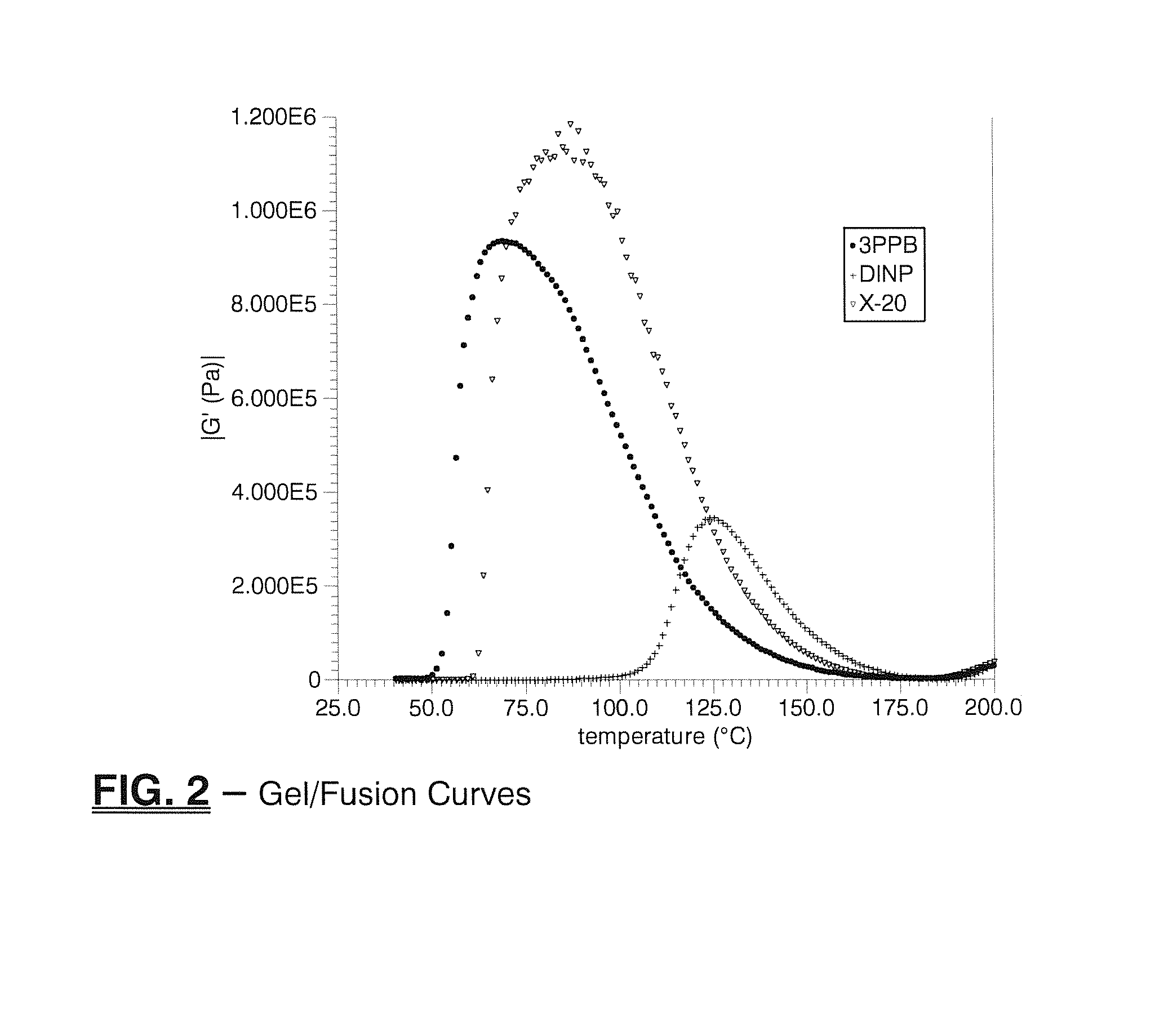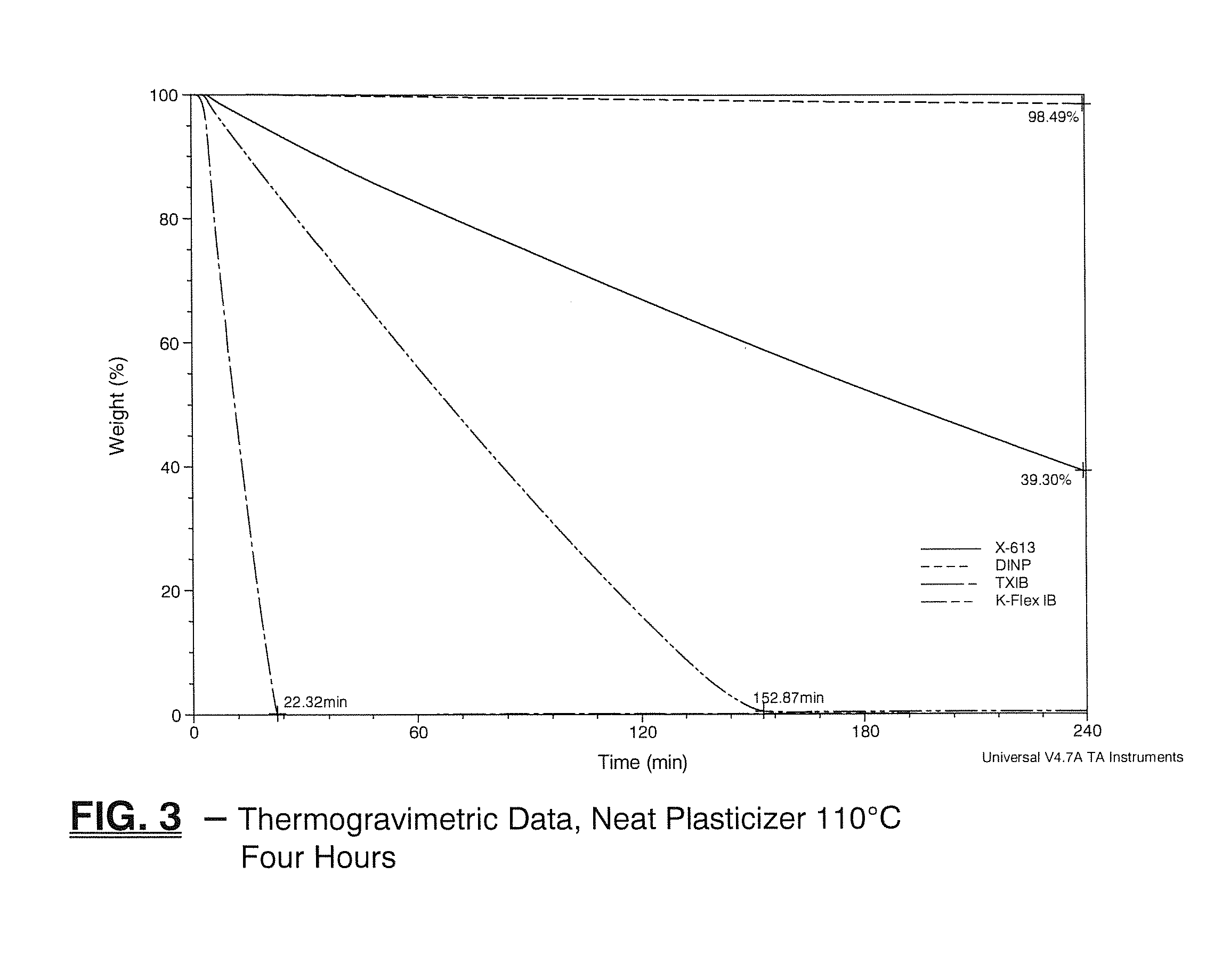Monobenzoate useful as a plasticizer in plastisol compositions
a monobenzoate, plasticizer technology, applied in the direction of adhesive processes with surface pretreatment, protein coatings, inks, etc., can solve the problems of increasing regulatory pressure, poor compatibility, and not always giving the performance desired in vinyl compositions, so as to achieve comparable or better performance and handling properties, and reduce the content of vo
- Summary
- Abstract
- Description
- Claims
- Application Information
AI Technical Summary
Benefits of technology
Problems solved by technology
Method used
Image
Examples
examples
[0078]Experimental Methodology
[0079]Plastisol and Vinyl Preparation:
[0080]The plastisols were prepared in a Hobart Model N-50 mixer. A ten minute mix at speed one (1) was used. A high speed disperser was also used to prepare other plastisols evaluated employing a ten minute mix at 1000 RPM's. All of the plastisols were degassed at 1 mmHg until as air free as possible.
[0081]The vinyl for the basic screen was fused in a closed mold at a thickness of 1.2 mm at 177° C. for 15 minutes in a Blue M oven.
[0082]Tests / Evaluations
[0083]The goal was to determine the basic performance parameters of the inventive plasticizer versus known or standard and currently available plasticizers. Tests demonstrating efficiency (Shore A and tensile properties), permanence (extraction and volatility) and processability (viscosity, viscosity stability, rheology, and gel / fusion) were utilized. Unless otherwise indicated in specific examples, the general tests and / or methodologies described below were used. The...
example 1
Basic Plastisol Evaluations—Processability
[0088]The following examples show the efficacy of the inventive monobenzoate with a basic starting plastisol formulation described below:
MaterialPHRDispersion Resin, K76, Geon 121 A100Plasticizer70Ca / Zn stabilizer, Mark 12213
[0089]The inventive monobenzoate was compared to K-FLEX® 975P (a new dibenzoate triblend (comprising 20 wt. % 1,2-propylene glycol dibenzoate and 80 wt. % of an 80 / 20 DEG / DPG dibenzoate blend) and DINP. FIG. 1 shows initial viscosity data obtained for the inventive monobenzoate, which compares favorably to a general purpose phthalate and reflects better rheology than the new dibenzoate triblend.
[0090]Table 1, below, reflects gel fusion values obtained for 3-PPB, 975 P (shown as X-20 in FIG. 1), and DINP (a general purpose phthalate plasticizer).
TABLE 1InitialG′ MaximumG′× G″InflectionTempModulusTempPlasticizerTemp (° C.)(° C.)(Pa)(° C.)3-PPB57811.6 × 106169975P58871.2 × 106168DINP791253.5 × 105177
[0091]FIG. 2 shows the g...
example 2
Basic Plastisol Evaluations—Processability, Permanence
[0092]The basic plastisol formulation of Example 1 was utilized in this example.
[0093]The inventive monobenzoate (X-613) was compared to DINP, IDB (isodecyl benzoate), and 2,2,4-trimethyl-1,3-pentanediol diisobutyrate (TXIB™, an Eastman trademark).
[0094]The thermogravimetric data of the neat plasticizers is shown in FIG. 3. The results demonstrate that 3-PPB is significantly less volatile than TXIB™ and IDB, has more permanence and provides a lower VOC alternative over these two plasticizers. An extended test showing volatile loss over 3 days at 70° C. comparing DINP, IDB and 3-PPB is shown in FIG. 4. The results show that 3-PPB is somewhat better than IDB in terms of volatility (permanence) over the three day period.
[0095]Initial, one-day and seven-day viscosities obtained for 3-PPB, DINP and IDB are shown in FIG. 5. This data demonstrates a higher viscosity for 3-PPB than that obtained for IDB, but much lower than the phthalate...
PUM
| Property | Measurement | Unit |
|---|---|---|
| wt. % | aaaaa | aaaaa |
| wt. % | aaaaa | aaaaa |
| thickness | aaaaa | aaaaa |
Abstract
Description
Claims
Application Information
 Login to View More
Login to View More - R&D
- Intellectual Property
- Life Sciences
- Materials
- Tech Scout
- Unparalleled Data Quality
- Higher Quality Content
- 60% Fewer Hallucinations
Browse by: Latest US Patents, China's latest patents, Technical Efficacy Thesaurus, Application Domain, Technology Topic, Popular Technical Reports.
© 2025 PatSnap. All rights reserved.Legal|Privacy policy|Modern Slavery Act Transparency Statement|Sitemap|About US| Contact US: help@patsnap.com



